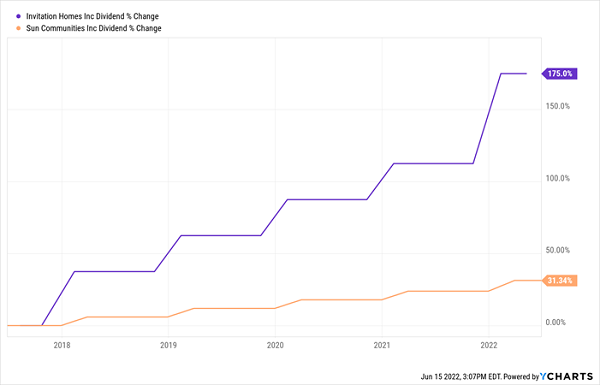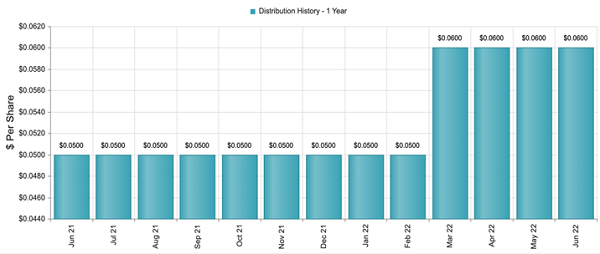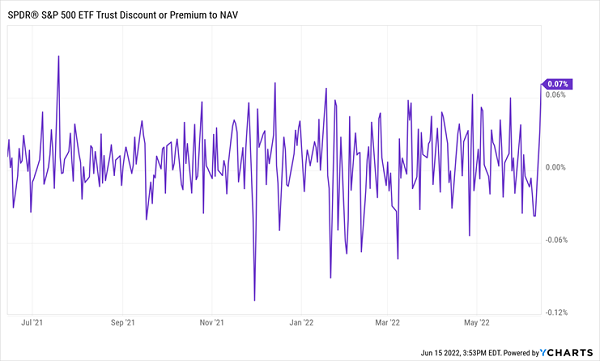Look, I’m as ready for this selloff to end as you are. And when stocks drop—sending dividend yields skyward—I so badly want to back up the truck.
As value-focused dividend investors, buying dips is what we live to do. Sitting in cash is agonizing to me, as I’m sure it is to you, too.
But it just isn’t time yet. Which is why I’ve recommended just one stock this year in my Contrarian Income Report service, while urging my readers to stockpile cash. And after last Thursday’s dumpster fire, we’re sure glad we did!
We’ve also lightened up our portfolio over these last few months, including taking some nice profits on three bank stocks we sold in May:

There was nothing wrong with these three: they were just benefiting from the Fed’s injection of cash into the markets, and the gap between the 10-year Treasury (at which they lend to clients) and the Fed’s policy rate (at which they lend to each other).
Now that Powell has overdone things and is letting the Fed rate rise, banks’ profit margins are being squeezed, so it was time to bid adieu. And we took some nice profits off the table by doing so.
Closed-End Funds Are At The Top Of Our List
One of the best things we’ll be very interested in buying when the smoke clears is high-yielding closed-end funds (CEFs). These vehicles are ideal because they often trade on the open market at different levels (and usually discounts!) than the per-share value of their portfolios, or net asset values (NAVs) in CEF-speak.
CEFs are cheap now, but I expect them to be even cheaper in a couple months. Then, when their “discount windows” slam shut (or revert to more normal levels), they’ll catapult our CEF prices higher.
That will be a very nice payoff for our patience today, on top of the 7%+ dividends CEFs regularly pay.
Let’s start to look toward those brighter days now, by starting our CEF shopping list. Here are three to put near the top:
“Shopping list” CEF No. 1: A Megatrend-Powered 6.3% Dividend
When it comes to CEF investing, we demand one more thing, beyond discounts and dividends: megatrends! And there’s simply no more predictable megatrend than the aging of the US population. Sure, it’s been totally overshadowed by COVID, but it’s still there—and it’s accelerating.
According to a recent Reuters report, about 16.5% of the US population, or roughly 54 million people, are over 65. By 2040—just 18 years from now—that number will jump to 74 million, a 37% increase.
That’s going to lead straight to higher healthcare spending, and our first “shopping list” pick is nicely positioned to profit: the BlackRock Health Sciences Fund (NYSE:BME), which yields 6.3% and sports a 2% premium to NAV that I expect to be taken out in the next few weeks, setting up a nice discount for us.
BME also helps ease back our risk by sticking with big pharma stocks like Johnson & Johnson (NYSE:JNJ), Pfizer (NYSE:PFE), and AbbVie (NYSE:ABBV).
Finally, this fund not only pays a high yield but is growing its payout, too, with a 6.5% increase announced last October. With the favorable trends we’ve got setting up for healthcare in the coming years, more hikes are likely on the way.
“Shopping List” CEF No. 2: A 10% Dividend From the Rise of “Rental Nation”
Sure, housing demand is softening, but with 30-year mortgage rates now around 6%, buying a home is still pricey. That’s causing many folks to change their house hunt to an apartment hunt.
Heck, there are now bidding wars for apartments—in Philadelphia, for example, renters are offering $500 or more a month above the advertised rent, according to recent reports.
A CEF that’s well-suited to this trend is the CBRE Clarion Global Real Estate Income Fund (NYSE:IGR), which devotes 16% of its portfolio to residential REITs, its second-biggest allotment.
Sun Communities (NYSE:SUI), which has mobile and manufactured-home parks across the south, is among its top-10 holdings, as is Invitation Homes (NYSE:INVH), which holds single-family homes in the west and Florida.
Both stocks have been rolling out healthy dividend hikes, including relatively large increases late last year:
IGR’s Top Residential Holdings Drop Steady Payout Raises
We love IGR’s diversification, too: its top-10 holdings include other REITs offering in-demand properties, like cell-tower REIT Crown Castle International (NYSE:CCI) and self-storage firms ExtraSpace Storage and CubeSmart (NYSE:CUBE).
IGR’s management team is doing a great job of handing the rising rent checks its portfolio companies are collecting over to us: it’s not often that you hear of a 10% dividend that’s growing (especially these days), but that’s exactly what’s happening with IGR:
IGR’s (Monthly) Dividend Yields 10% and Is Growing Quickly
Source: CEF Connect
IGR is a textbook case of why we’re holding off on buying now: despite the market carnage, it trades at a 0.85% premium. As is the case with our first pick, I expect that premium to be taken out in the coming weeks, setting up a discount opportunity (and a potentially even higher yield).
“Shopping List” CEF No. 3: A 93-Year-Old Fund That’s Seen Everything
Tri Continental Closed Fund (NYSE:TY)) isn’t going to break records for its dividend: it yields 4.6%, low by CEF standards. But given the choice between TY and an index fund, I’ll take TY every time.
I’m making that comparison, by the way, because TY owns the same stuff as the benchmark SPDR® S&P 500 (NYSE:SPY), including Apple (NASDAQ:AAPL), Pfizer (PFE), Exxon Mobil (NYSE:XOM), and Dow Inc. (NYSE:DOW). It cobbles together this blue-chip stock portfolio for a dividend that’s triple the 1.5% SPY pays.
Plus you get a deep discount, which clocks in at 12.4%, below the 8.3% TY has averaged in the past year, and I suspect we’re going to get an opportunity to buy for even less.
I don’t know about you, but I’d rather get S&P 500 exposure with more of my return in dividend cash and at a discount! Which, by the way, is something ETFs like SPY never offer:
SPY Is Never Cheap
Finally, we’ll get a ton of institutional memory with this one: TY was launched in 1929, just before the Great Depression, so it’s dealt with everything the economy can throw at it, including rising rates. That may be why, unlike most other CEFs, TY uses almost no leverage—just 3% of the portfolio at last check.
Disclosure: Brett Owens and Michael Foster are contrarian income investors who look for undervalued stocks/funds across the U.S. markets. Click here to learn how to profit from their strategies in the latest report, "7 Great Dividend Growth Stocks for a Secure Retirement."
